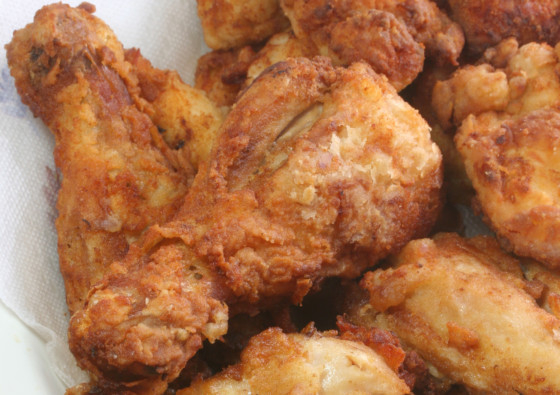
Britain is in the grip of an invasion. Our treasured national collection of Kebab-u-Likes, Codfathers and Pizza the Actions is under threat from a new breed of Kennedy Fried Chickens, Chicken Cottages and the singularly unappetising rash of Chicken Spots. In the past decade, we've all gone potty for poultry.
Of course, the Colonel's advance guard arrived here in 1965 (indeed, he came over in person to open the first UK franchise in Preston), but this explosion is a more recent phenomenon — sales of fried chicken grew by 36 per cent in the five years up to 2008, 14 per cent more than the fast food sector as a whole.
It can’t be denied that, done well, it’s pretty addictive stuff: juicy meat (on the bone for maximum flavour) encased in a crisp, salty and yes, ever-so-slightly greasy crust is always going to be an attractive prospect. And while there are a few trendy food vans serving up gourmet versions, for most of us the best way to indulge is at home. That way, you can tell exactly what lurks beneath that finger-lickin’ good batter.
THE CHICKEN
Many fried chicken recipes suggest you start with a whole bird and joint it yourself, but, from experience, I’d recommend forgetting the bland breasts, which take an age to cook through and aren’t really worth it anyway, and concentrating on thighs and drumsticks. (Wings, I find, don't supply enough meat for the weight of batter.) Controversially, I’d suggest removing the skin — it doesn’t crisp up properly under the coating, and is inevitably rubbery and disappointing unless you’re making it for a Kentucky church picnic, in which case, your reputation depends on leaving it on in the time-honoured southern fashion.
THE MARINADE
Many fried chicken recipes marinate the meat first to ensure maximum juiciness — either in brine, milk or buttermilk, or a combination of the two. How traditional this is is unclear — Mary Randolph’s 1824 recipe in The Virginia House-Wife doesn’t call for it, and neither does the 1881 work, What Mrs Fisher Knows About Old Southern Cooking but it’s certainly popular today.
Atlanta’s Scott Peacock, protégé of the legendary southern chef Edna Lewis, brines his chicken overnight and then soaks it in buttermilk for another 8-10 hours, while Thomas Keller marinates it in a brine flavoured with lemon and fresh herbs, dipping it in buttermilk briefly just before cooking.
Richard Ehrlich suggests milk, buttermilk or milk and yoghurt, and Tim Hayward plumps for milk — I let all of these sit overnight, while New York’s Clinton Street Baking Co recommends only 3-4 hours in buttermilk. Maverick Laurie Colwin, meanwhile, doesn’t bother with any kind of marinade in her recipe in the classic Home Cooking, specifiying only that the chicken be brought up to room temperature before cooking. Instead she bathes the meat briefly in water or milk to give the flour something to stick to, which works perfectly well, although water does make things dangerously flaky.
I find the brined recipes, while doing a good job in the juiciness department (although Keller’s chicken isn’t particularly tender), make the chicken unpalatably salty — in Keller's case, thanks to the lemon and herbs, it tastes like another dish entirely, and one with far more pretensions to grandeur. I can’t detect much difference in tenderness between the buttermilk and milk marinades, but the buttermilk gives the longer-marinated chicken a tangier flavour, and is a better base for the flour to cling to than milk or water.
The Clinton Street Baking Co adds spice to their marinade rather than the coating, seasoning it with salt, cayenne pepper, onion powder, black pepper, garlic powder and dried thyme. I don’t think much of this cornucopia comes through in the finished dish, but I will be salting my buttermilk marinade, to give the chicken a helping hand in the flavour department.
COATING
Fried chicken is strictly a floured affair — battered chicken being something else entirely. As Colwin says, “no egg, no crumbs, no crushed Rice Krispies”. However, it’s a delicate balance: while the coating should be solid and crunchy, it shouldn’t imprison the chicken in what Ehrlich memorably describes as “a sarcophagus” of stodge.
Indeed, Peacock is very careful to avoid this, wiping off as much buttermilk as possible before lightly dredging the pieces in “just the idea of flour”. This makes his coating much lighter than, say, the Clinton Street Baking Co version, which explicitly instructs the cook not to drain off the spiced marinade before adding the flour. Their crust is thick and, in parts, slightly flabby.
I like the Baking Co’s idea of adding cornmeal to the flour coating, but actually, a well-fried piece of chicken should be crisp enough to render such an addition all but pointless. Peacock uses a mixture of corn and plain flour, the corn flour, presumably for lightness and crispness, but I don’t find it makes any discernible difference when deployed in such a small quantity.
The coating can play host to any number of flavourings including KFC’s “11 secret herbs and spices” — although, traditionally, salt and pepper were deemed sufficient. Hayward, in his quest to produce a rival “Guardian Fried Chicken”, goes for smoked paprika, mustard powder, sage, celery seeds, sugar, dried onion, salt and black and white pepper a coating so heavily spiced I could eat it on its own, but which (to my mind) obscures the flavour of the meat.
Keller adds garlic and onion powders, paprika, cayenne, salt and pepper (too allium-y), while Clinton Street, Peacock and Ehrlich stick to plain salt and pepper, with Colwin allowing for a pinch of paprika on the reasonable grounds that “I adore [it] and feel it gives the chicken a smoky taste and a beautiful colour”.
I’m with her: too many herbs and spices smack of something to hide. You should be able to taste the chicken.
COOKING METHOD
Fried chicken is fried chicken, right? Well, if, like me, you assumed there wasn’t much variation between recipes, think again: “contrary to popular belief,” Colwin announces crisply, “fried chicken should not be deep-fried”. She, like Richard Ehrlich, shallow-fries hers, turning it halfway through, but, unlike him, she covers the pan for the first 12 minutes, then turns up the heat until it’s fried “to the colour of Colonial pine stain”. “The idea of covering frying chicken makes many people squeal,” she admits, “but it is the only correct method.”
What’s so clever about it is that it means the chicken cooks through quickly, before the coating has time to burn, and stays beautifully moist inside (the reason, I suspect, Colwin’s doesn’t suffer too much from a lack of marinade).
Hayward’s method is equally clever, poaching the chicken in its milky marinade and allowing it to cool in the liquid before flouring makes for meat so tender it almost falls off the bone. The short frying time needed, however, doesn’t allow the coating to get quite as crisp as I'd like and poaching does seem a little bit like cheating, if I’m honest.
Deep-frying, such as Keller and Peacock, is more difficult to control, giving a more even, but not quite so crisp shell, presumably, as this thread online suggests, because it hasn’t had anything to form against.
Vegetable or groundnut oil are the standard frying media.
PERFECT SOUTHERN FRIED CHICKEN
Fried chicken will never be a health food. Nor indeed should it be a regular indulgence, not only for the sake of your heart, but your soft furnishings too as the redoubtable Colwin observes, "there are many disagreeable things about frying chicken". The end result, however, is not one of them.
Serves 2-3
300ml buttermilk
1 tsp salt
6 pieces of chicken (I use a mixture of legs and thighs)
150g plain flour
1/2 tsp salt
1/2 tsp black pepper, freshly ground
1/2 tsp paprika, smoked
Vegetable oil, for frying
Combine the buttermilk and salt in a bowl large enough to hold the chicken, and add the meat, spooning the buttermilk over it to coat. Cover and refrigerate for about 8 hours, allowing it to return to room temperature before cooking.
Put the flour, salt and spices in a large, flat dish and whisk briefly to combine. Put 1.5cm of vegetable oil into a wide, straight-sided pan with a lid and heat until very hot: a cube of bread should brown almost immediately (about 170C). Wipe as much buttermilk off the chicken pieces as possible then roll them in the seasoned flour until thoroughly coated.
Put the chicken in one layer in the pan (you may need to do this in batches, depending on the size of the pan) and cover. Turn the heat right down and simmer for 6 minutes, then turn the chicken pieces over, cover again and cook for another 6 minutes. Prepare a rack to drain the chicken.
Turn the heat up and fry the chicken until it’s a deep golden colour on all sides. Transfer to the rack and blot with kitchen paper. Allow to cool slightly before serving.
Guardian News and Media Limited












